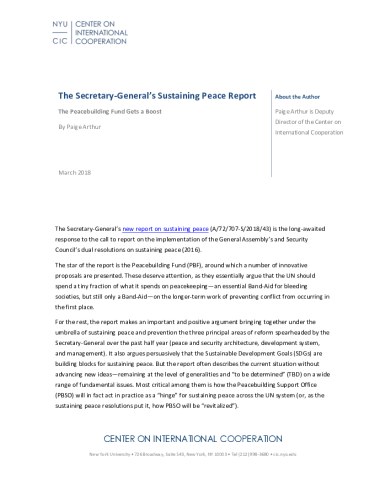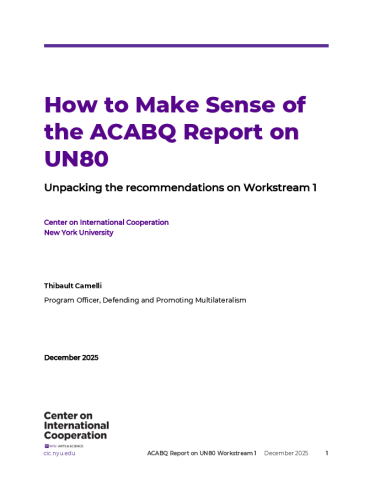The Secretary-General’s new report on sustaining peace (A/72/707-S/2018/43) is the long-awaited response to the call to report on the implementation of the General Assembly’s and Security Council’s dual resolutions on sustaining peace (2016).
The star of the report is the Peacebuilding Fund (PBF), around which a number of innovative proposals are presented. These deserve attention, as they essentially argue that the UN should spend a tiny fraction of what it spends on peacekeeping—an essential Band-Aid for bleeding societies, but still only a Band-Aid—on the longer-term work of preventing conflict from occurring in the first place.
For the rest, the report makes an important and positive argument bringing together under the umbrella of sustaining peace and prevention the three principal areas of reform spearheaded by the Secretary-General over the past half year (peace and security architecture, development system, and management). It also argues persuasively that the Sustainable Development Goals (SDGs) are building blocks for sustaining peace. But the report often describes the current situation without advancing new ideas—remaining at the level of generalities and “to be determined” (TBD) on a wide range of fundamental issues. Most critical among them is how the Peacebuilding Support Office (PBSO) will in fact act in practice as a “hinge” for sustaining peace across the UN system (or, as the sustaining peace resolutions put it, how PBSO will be “revitalized”).
PBF funding: specific proposals to address a real gap
Noting the high cost of responding to conflict, and citing data analysis from the 2017 UN-World Bank (WB) joint study, Pathways for Peace, which makes the case for the cost effectiveness of preventive action, the report turns to the PBF as the central UN vehicle for financing preventive activities. Calling for a “quantum leap” in flexible, multiyear contributions to the PBF, the Secretary-General lays out a number of options. These include:
- Closing inactive trust funds and allocating their resources to the PBF
- Asking member states to allocate the equivalent of $100 million or 1 percent of the annual peacekeeping budget from assessed contributions to the PBF (following a recommendation in the report of the 2015 Advisory Group of Experts [AGE] on the UN Peacebuilding Architecture)
- Capturing some of the variance in spending between annual peacekeeping budgets; suggesting that if the annual budget decreases, then member states could be asked to commit 15 percent of that decrease (or savings) to the PBF
- Allocating unspent, end-of-year balances from peacekeeping missions to the PBF
The Secretary-General also makes proposals not linked to the PBF. On an administrative level, he is proposing to reduce fragmentation through development of a “funding dashboard” and enhanced use of pooled funds. To prevent the “financial cliff” that occurs after peace operations’ drawdowns, he is asking the largest donors to the peacekeeping budget to voluntarily pledge 15 percent of the final full-year budget of the mission for two years after the mission closes. He also encourages enhanced use of programmatic funding from the peacekeeping budget to support peacebuilding activities. The challenge with some of these ideas, it must be admitted, lies at the source of funds, rather than with the UN. Most countries’ contributions to the peacekeeping budget are controlled by a different ministry than their other contributions (for example, development). Countries often criticize the UN for not being able to work across “silos,” but this is a case where they should prove that they can do the same.
In making these proposals, the Secretary-General is putting politically challenging issues squarely on the table and asking member states to back up the rhetoric on sustaining peace and prevention with meaningful resources. The proposals will face stiff resistance, as they are taking place against a headwind of cuts to the UN budget. It is notable that the proposals generally steer away from potential allocation of money away from the peacekeeping budget, focusing on provision of supplementary funds. The latter approach will be more satisfactory for DPKO, which is already facing a difficult (and, for many, demoralizing) reform process. The Secretary-General is unlikely to get all that is being asked for, but getting any of it would signal real change.
The Secretary-General was asked to present options, and that he has done. One risk, however, with so many asks on the table is that sympathetic member states may not have sufficient clarity about what the Secretary-General really wants, and which of these asks to advocate the hardest for. Some might have wished for him to present a single vision that they could solidly get behind.
Bringing together the three reform tracks
Observers following the UN and interested in sustaining peace have noticed that the Secretary-General’s proposals over the last half year for reforming the UN have not always clearly articulated their links to the sustaining peace and prevention approach. There was a worry that the sustaining peace report would not be taken as an opportunity to bring these parallel tracks together.
That worry is allayed to some degree with the report in front of us. As sensitive as the issue is for some countries, the Secretary-General links sustaining peace to his development reform proposals, and argues that all three reform tracks are needed if the UN is to be a more effective and credible actor on sustaining peace and prevention. The key to the argument is the reduction of fragmentation across the system, driving a coherent, system-wide approach to addressing drivers of conflict. The complex, transnational challenges of prevention—ably described in the UN-WB Pathways for Peace report—require drawing on capacities across the UN system and outside of it. For this to happen, he argues, the UN needs much more flexibility and innovation in, for example, its country teams, Resident Coordinator system, and approach to partnerships. It needs more focus on common objectives, especially around UNDAFs, and, in conflict contexts, UNDAF+ strategies. The PBC needs to be empowered to work across the system to flexibly convene and to recommend. The SDGs should be leveraged as a development approach to risk-informed support to member states. And more structures for coordinated work across entities need to be put in place.
Too much “TBD”
As much as the report offers, and it certainly ticks all the boxes from the sustaining peace resolutions, there is too much in it that is left unsatisfyingly “to be determined.” This is particularly the case with challenges that have been recognized since the 2015 “year of reviews” (HIPPO, AGE, and implementation of SCR 1325), and that therefore one might have expected this report to tackle. There is indeed a contrast between the specific nature of proposals made for the PBF, and the more general recommendations in the rest of the report. Where specifics are mentioned, these are often the same specifics already mentioned in previous reports. One might have hoped for something more visionary, even if this was not required by the sustaining peace resolutions.
The biggest example of this gap—from the perspective of a report on sustaining peace—is that the we are left wanting new ideas on how PBSO will, as a matter of practice, act as a “hinge” (or be “revitalized”) within the UN system. Within the peace and security architecture, a few issues waiting for clarity include how PBSO will engage with the new regional bureaus created within the peace and security architecture; how it will relate to the parallel and complementary thematic work undertaking by DPKO’s Office of Rule of Law and Security Institutions; and, in relation to the development and human rights pillars, what structures or practices will facilitate a role for PBSO in bringing these actors together on sustaining peace.
Similar to the PBSO hinge function, there are many moments in the report where one is left with the question, but how will this change? Whether this is in relation to enhanced integration at country level, the production and consistent use of joint analysis across the system, risk-informed approaches, the need for good leaders with a diversity of experiences—these are challenges that have already been identified; they pose concrete practical and political difficulties; and for these reasons they remain unresolved issues to this day.
High stakes and high expectations
Of course, it is unfair to expect a single report to solve every challenge. Also, because there are so many moving pieces at the UN right now, it would be untimely to make too many proposals when major structural questions are still not settled. The Secretary-General has placed sustaining peace and prevention at the center of his agenda, but moving the UN system around that goal is indeed a daunting challenge.
The Secretary-General’s report pushes the discussion in some areas more than others, and perhaps this balance is the result of a calculated gamble. The proposals on PBF financing are welcome and will provoke heated discussion. Placing the three reform tracks in the context of sustaining peace and prevention is critical at this moment, when there is a sense that the momentum on sustaining peace may be fizzling. Nonetheless, more fresh ideas are wanting in order to push the system in a new direction. With any hope, the strong sections of this report are a signal of more to come on other issues in the near future.
Download the full commentary The Secretary-General’s Sustaining Peace Report: The Peacebuilding Fund Gets a Boost
Acknowledgments: CIC acknowledges the Swedish Ministry of Foreign Affairs, the Ministry of Foreign Affairs of the Kingdom of the Netherlands, the Norwegian Ministry of Foreign Affairs, and the Swiss Federal Department of Foreign Affairs for their support for this briefing.



